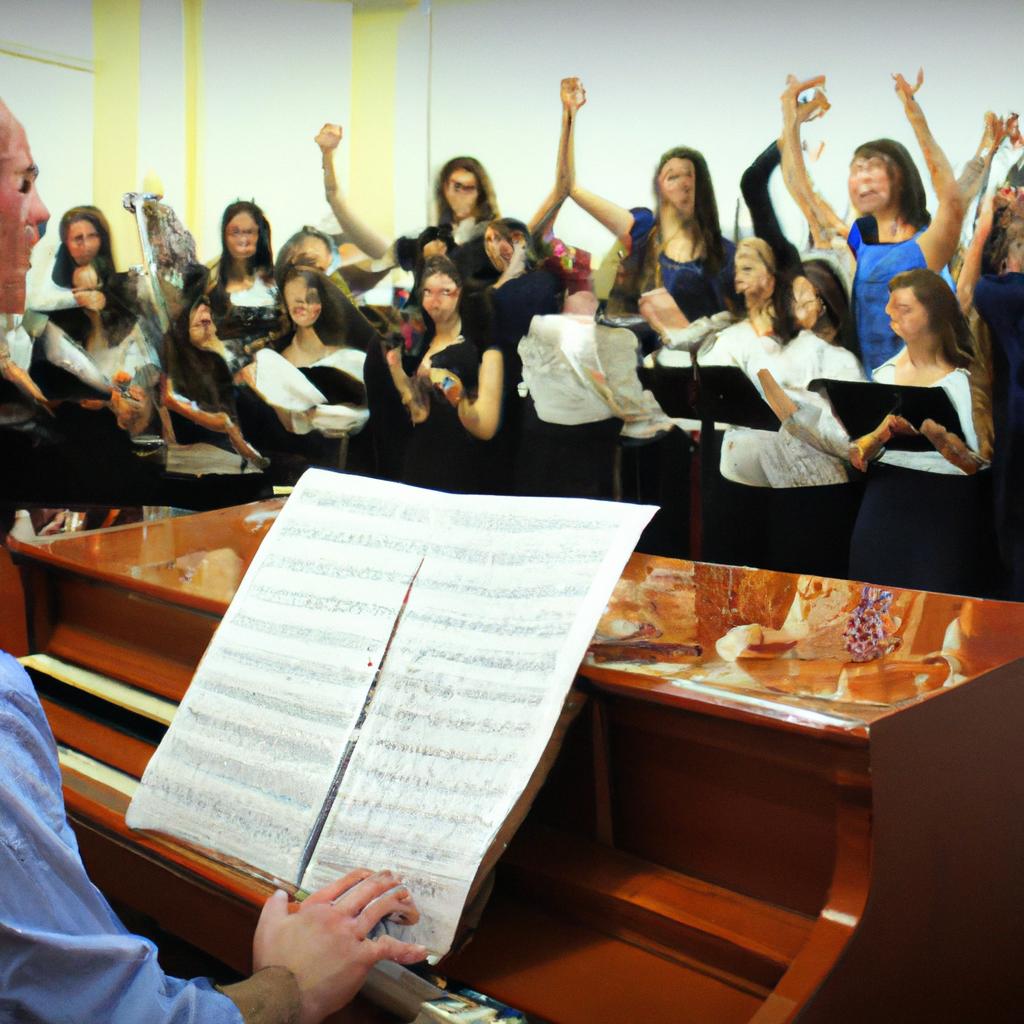The study of vocal registers in vocal ensembles is a topic that has fascinated music scholars for decades. The exploration and understanding of these distinct ranges of the human voice play a crucial role in achieving harmonic balance within choral groups. Consider, for instance, a hypothetical scenario where an amateur choir struggles to blend their voices effectively due to differences in their individual registers. Understanding how different voices interact and harmonize can help choirs navigate these challenges and create seamless musical performances.
In this article, we delve into the fascinating world of vocal registers in vocal ensemble settings. By examining the various types of registers present within a group, we aim to shed light on the importance of harnessing each singer’s unique range to achieve optimal harmony. Through analyzing case studies and drawing upon established research, we will explore techniques utilized by conductors and singers alike to develop cohesion among differing registers. Furthermore, we will discuss the impact that mastering register transitions can have on enhancing overall ensemble sound quality, emphasizing the significance of proper technique in delivering captivating performances.
Understanding Vocal Registers
Imagine attending a vocal ensemble performance where the harmonies effortlessly blend, creating an enchanting musical experience. Behind this seamless fusion lies the concept of vocal registers. Vocal registers refer to distinct ranges within a singer’s voice that contribute to the overall tonal quality and versatility. Understanding these registers is crucial for singers and vocalists alike in order to maximize their potential and achieve captivating performances.
The Importance of Register Knowledge:
To comprehend the significance of vocal registers, consider a hypothetical case study involving two singers with similar abilities but different understandings of register utilization. Singer A possesses comprehensive knowledge about various vocal registers and skillfully transitions between them, resulting in dynamic and expressive renditions. In contrast, Singer B lacks awareness of proper registration techniques, leading to strained vocals and limited artistic range. This example emphasizes how understanding vocal registers can profoundly impact one’s ability to effectively convey emotions through singing.
Emotional Impact:
- Confidence: Mastery over vocal registers instills confidence in performers, enabling them to explore diverse musical genres without hesitation.
- Authenticity: By tapping into different registers, singers can express themselves authentically, making each performance unique and relatable.
- Connection: The use of appropriate registers allows artists to establish emotional connections with audiences by evoking specific moods or sentiments.
- Artistic Freedom: Acquaintance with multiple vocal registers empowers musicians to experiment creatively, fostering innovation within the realm of music.
Table – Key Vocal Registers:
| Register | Description | Examples |
|---|---|---|
| Chest | Lower range resonating from the chest cavity | Adele’s powerful low notes |
| Head | Higher range produced through resonance in the head | Mariah Carey’s soaring high notes |
| Mixed | Combination of chest and head resonance for versatile mid-range | Freddie Mercury’s signature sound |
| Falsetto/Whistle | Controlled use of breath and vocal cords for ethereal, airy tones | Prince’s falsetto in “Purple Rain” |
Understanding the fundamental concepts behind various vocal registers lays a strong foundation. Now that we have explored the significance of register knowledge, let us delve into an exploration of the different types of vocal registers. By further examining these distinctions, singers can enhance their understanding and harness the full potential of their voices.
Different Types of Vocal Registers
Transitioning smoothly from our previous discussion on understanding vocal registers, let us now delve into the different types that exist within a vocal ensemble. To illustrate their significance, we will explore the case of a hypothetical vocal group called Harmony Voices.
Harmony Voices is an acclaimed vocal ensemble consisting of six members with distinctly unique voice types. As they perform various musical pieces, each member showcases their expertise by seamlessly transitioning between different registers. This ability to navigate through registers not only adds depth and complexity to their performances but also enhances the overall harmony of their collective sound.
To fully grasp the impact of different vocal registers in a vocal ensemble, consider the following emotional responses evoked by this artistic technique:
- Euphoria: The melodic interplay created when voices transition from lower to higher registers can evoke feelings of elation and bliss among listeners.
- Tenderness: When softer and lighter registers are employed, it often conveys a sense of vulnerability and tenderness in the interpretation of lyrics or emotions conveyed through music.
- Intensity: By utilizing powerful and resonant upper register notes, performers can generate an intense atmosphere that captivates the audience’s attention and stirs deep emotions.
- Balance: Skillfully blending multiple registers allows for balanced harmonies within the ensemble, resulting in a cohesive sonic experience that pleases both ear and soul.
To better understand how these emotional responses manifest within a vocal ensemble like Harmony Voices, let us examine the table below showcasing each member’s primary register type:
| Member | Primary Register |
|---|---|
| Sarah | Soprano |
| Jack | Tenor |
| Emily | Mezzo-Soprano |
| Michael | Baritone |
| Laura | Alto |
| David | Bass |
Through the careful selection and arrangement of vocal parts, Harmony Voices creates a rich tapestry of sound that showcases their individual register strengths while harmonizing beautifully as an ensemble. This dynamic interplay between different registers allows for an intricate exploration of musical nuances and expression.
As we conclude this section on the various types of vocal registers within a vocal ensemble, it becomes evident how essential they are in shaping the overall artistic experience. Moving forward, let us explore the role these registers play in creating cohesive harmonies and captivating performances within a vocal ensemble setting.
The Role of Vocal Registers in Vocal Ensemble
Having discussed the various types of vocal registers in the previous section, it is now essential to delve deeper into their distinct characteristics and how they contribute to the overall harmonious blend within a vocal ensemble.
Understanding these unique qualities will enable us to appreciate the intricate dynamics that occur when different voices come together. To illustrate this concept, let us consider an example of a hypothetical vocal ensemble comprising four singers with contrasting voice types: soprano, alto, tenor, and bass.
-
The Soprano Register:
The soprano register embodies a bright and crystalline timbre that effortlessly soars above other voices. Its higher pitch range allows for delicate melodic lines and ethereal harmonies. Picture a soloist hitting breathtaking high notes during a soaring chorus—a moment that captures both awe and inspiration. -
The Alto Register:
Contrasting the soprano, we find the alto register exuding warmth and richness in its lower range. This allows altos to provide depth and resonance to choral arrangements. When blended skillfully with other voices, such as those found in barbershop quartets or gospel choirs, altos create a strong foundation upon which melodies can be built. -
The Tenor Register:
Moving on to the tenor register, we encounter a voice type characterized by its versatility—able to navigate between high ranges like sopranos while also dipping into lower octaves similar to some altos. With their ability to seamlessly transition across pitches, tenors often take on crucial roles in harmonizing melody lines with other vocal parts. -
The Bass Register:
Lastly, we have the bass register—an embodiment of deep sonorous tones that ground any composition with power and gravitas. Comparable to solid pillars supporting an architectural masterpiece, bass voices add stability and texture through resonant low notes that resonate throughout musical works spanning genres such as opera, acapella, and even barbershop quartets.
In exploring the distinct characteristics of each vocal register, we gain a deeper appreciation for the diverse contributions they make within a vocal ensemble. By understanding how these registers interact and blend harmoniously, we can now move on to techniques that aid in developing them further.
As we continue our exploration into the world of vocal registers, let us now turn our attention towards essential techniques for enhancing and refining these unique vocal qualities.
Techniques for Developing Vocal Registers
Building upon the understanding of the significance of vocal registers within a vocal ensemble, we now delve into techniques for developing and honing these registers. By exploring various approaches and exercises, singers can enhance their abilities to seamlessly blend their voices while maintaining distinct tonal qualities.
Section H2: Techniques for Developing Vocal Registers
Developing vocal registers is an essential aspect of nurturing individual versatility within a vocal ensemble. To illustrate this point, let us consider a hypothetical scenario involving an amateur choir aiming to improve its overall performance by refining vocal register transitions.
Case Study Example:
Imagine a community choir preparing for a challenging choral piece that requires seamless shifts between chest voice and head voice. In order to achieve cohesion and unity among the group members, it becomes imperative for each singer to develop control over both registers.
To effectively cultivate the development of vocal registers, several techniques can be employed:
-
Breath Control Exercises:
- Diaphragmatic breathing drills
- Sustained note exercises with emphasis on breath support
- Gradual increase in sustained note duration
-
Resonance Training:
- Placement exercises targeting specific resonating areas (e.g., nasal or frontal)
- Humming exercises focusing on forward resonance
- Tongue placement exercises such as tongue twisters
-
Articulation Practice:
- Diction exercises emphasizing clarity and precision
- Consonant drills promoting articulatory agility
- Vowel modification exercises for optimal tone production
-
Range Expansion Workouts:
- Ascending/descending scale patterns across different octaves
- Interval leaps practice spanning multiple registers
- Controlled glissando exercises incorporating full range utilization
These techniques serve as crucial tools for individuals seeking to refine their vocal registers and facilitate harmonious ensemble singing. By incorporating these exercises into their practice routines, singers can develop a greater sense of control and flexibility in transitioning between registers.
Having explored the techniques for developing vocal registers, we now turn our attention to the challenges that arise when blending different register qualities within an ensemble setting. In the subsequent section, we will examine potential solutions to address these hurdles effectively.
Challenges and Solutions for Vocal Registers in Ensemble Singing
To illustrate these challenges and their corresponding solutions, let us consider a hypothetical case study of an amateur vocal ensemble preparing for a choral competition. The group consists of singers with varying levels of experience and proficiency. As they begin rehearsing a complex repertoire that requires mastery of different vocal registers, several obstacles arise:
-
Coordination and Blend:
- Maintaining uniformity across voices can prove challenging when each singer possesses unique qualities.
- Solution: Emphasize listening skills through focused ear-training exercises to foster blend and synchronization within the ensemble.
-
Balance and Control:
- Different registers may require adjustments in volume, dynamics, or tonal quality, making it difficult to achieve balance among individual voice parts.
- Solution: Offer specific guidance on breath support techniques tailored to each register, enabling singers to control their sound while maintaining an appropriate balance within the ensemble.
-
Range Extension:
- Some singers may struggle with transitioning smoothly between registers due to limitations in their vocal range.
- Solution: Incorporate targeted warm-up exercises aimed at expanding vocal range gradually over time, allowing each singer to develop greater flexibility between registers.
-
Vocal Fatigue:
- Extended rehearsals or performances demanding frequent use of certain registers can lead to exhaustion and strain on the vocal cords.
- Solution: Implement regular breaks during rehearsals, encourage proper hydration practices, and provide guidance on healthy vocal care routines to minimize fatigue risks.
In conclusion, addressing these challenges by implementing effective strategies helps ensure a harmonious exploration of vocal registers within an ensemble setting. By fostering coordination and blend, promoting balance and control, extending singers’ ranges, and prioritizing vocal health, ensembles can overcome hurdles associated with working across multiple registers.
Exploring the Expressive Potential of Vocal Registers, we now turn our attention to how different register techniques can be utilized to enhance artistic interpretations within ensemble performances.
Exploring the Expressive Potential of Vocal Registers
Building upon the challenges and solutions explored in the previous section, this section delves into the expressive potential of vocal registers within a vocal ensemble context. By understanding how different registers contribute to harmonious musical arrangements, performers can enhance their artistic interpretations and create captivating performances.
Exploring Vocal Registers in Ensemble Singing
To illustrate the impact of vocal registers on ensemble singing, let us consider a hypothetical case study involving an acapella group aiming to convey a range of emotions through their performance. The group consists of six singers with varying voice types, each possessing unique qualities that contribute to the overall texture and tonal richness of the ensemble’s sound.
- Elicit excitement by seamlessly transitioning from powerful chest voice to delicate head voice.
- Create a sense of longing or melancholy through sustained notes in falsetto register.
- Convey tenderness by blending voices in soft mix/belting technique.
- Establish authority and power through resonant full-throated tone.
In order to better understand the distribution of vocal registers within this fictional ensemble, we present a table showcasing the primary roles assigned to each singer:
| Singer | Voice Type | Primary Register |
|---|---|---|
| Sarah | Soprano | Head voice |
| Emily | Mezzo-soprano | Chest/mix |
| Jake | Tenor | Falsetto |
| Alex | Countertenor | Falsetto/head |
| Michael | Baritone | Chest |
| Ryan | Bass | Chest/subharmonic |
Through strategic allocation of parts based on individual strengths and preferences, this diverse ensemble is able to maximize its expressive potential. By utilizing various registers such as head voice for soaring melodies, falsetto for ethereal moments, and chest voice for grounding harmonies, they craft compelling narratives that resonate with their audience.
In conclusion, understanding the intricate interplay of vocal registers within a vocal ensemble setting is crucial for creating captivating performances. By harnessing the emotional impact of different registers, performers can craft harmonious musical arrangements that convey a range of emotions and captivate listeners. As singers explore their individual capabilities and work in tandem with their fellow musicians, they unlock a world of artistic possibilities through the exploration of vocal registers.
 Richmond Mens Chorus
Richmond Mens Chorus



